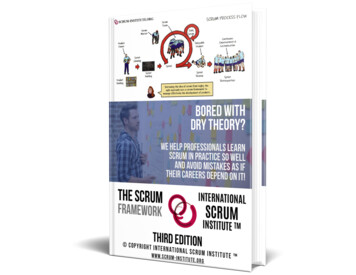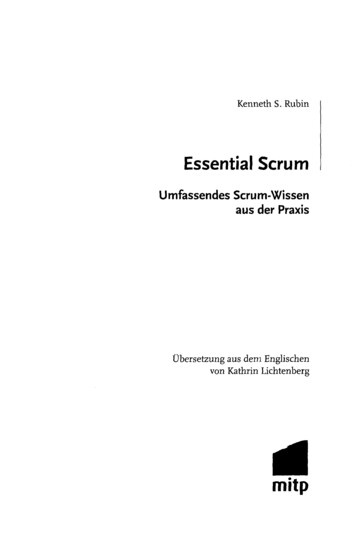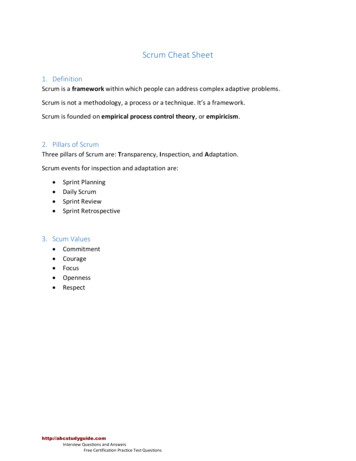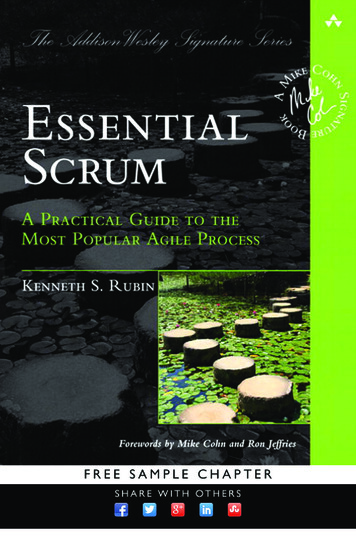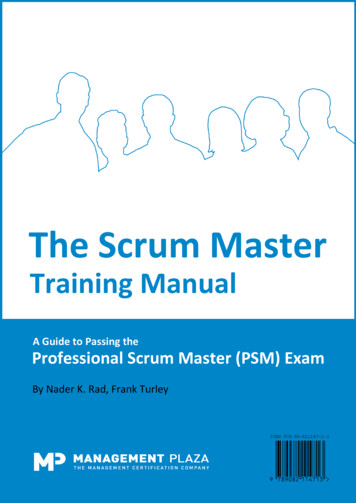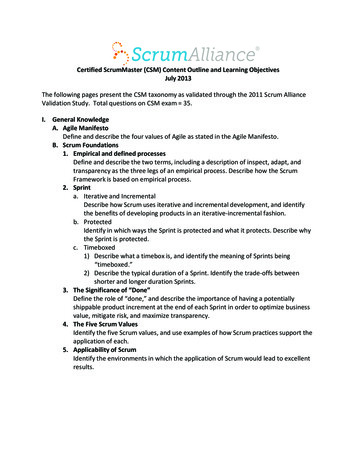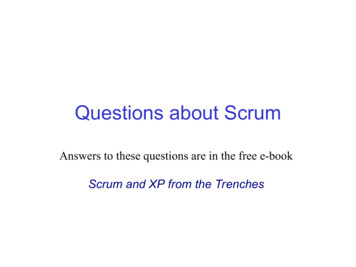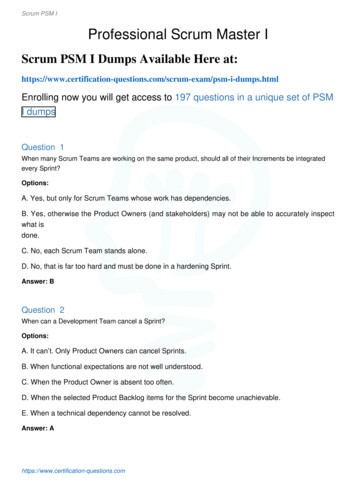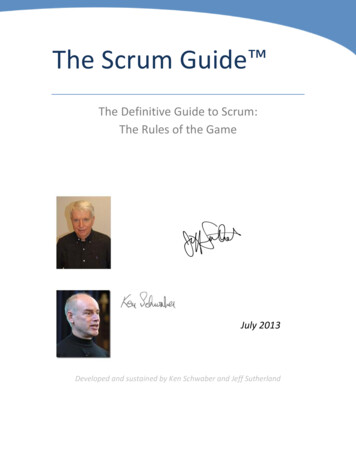
Transcription
The Scrum Guide The Definitive Guide to Scrum:The Rules of the GameJuly 2013Developed and sustained by Ken Schwaber and Jeff Sutherland
Table of ContentsPurpose of the Scrum Guide . 3Definition of Scrum. 3Scrum Theory . 3The Scrum Team . 4The Product Owner . 5The Development Team . 5The Scrum Master . 6Scrum Events . 7The Sprint . 7Sprint Planning . 8Daily Scrum . 10Sprint Review. 11Sprint Retrospective . 12Scrum Artifacts . 12Product Backlog . 12Sprint Backlog . 14Increment . 15Artifact Transparency . 15Definition of “Done” . 15End Note. 16Acknowledgements . 16People . 16History . 16 2014 Scrum.Org and ScrumInc. Offered for license under the Attribution Share-Alike license of Creative Commons,accessible at lcode and also described in summary form athttp://creativecommons.org/licenses/by-sa/4.0/. By utilizing this Scrum Guide you acknowledge and agree that youhave read and agree to be bound by the terms of the Attribution Share-Alike license of Creative Commons.Page 2
Purpose of the Scrum GuideScrum is a framework for developing and sustaining complex products. This Guide contains thedefinition of Scrum. This definition consists of Scrum’s roles, events, artifacts, and the rules thatbind them together. Ken Schwaber and Jeff Sutherland developed Scrum; the Scrum Guide iswritten and provided by them. Together, they stand behind the Scrum Guide.Definition of ScrumScrum (n): A framework within which people can address complex adaptive problems, whileproductively and creatively delivering products of the highest possible value.Scrum is: LightweightSimple to understandDifficult to masterScrum is a process framework that has been used to manage complex product developmentsince the early 1990s. Scrum is not a process or a technique for building products; rather, it is aframework within which you can employ various processes and techniques. Scrum makes clearthe relative efficacy of your product management and development practices so that you canimprove.The Scrum framework consists of Scrum Teams and their associated roles, events, artifacts, andrules. Each component within the framework serves a specific purpose and is essential toScrum’s success and usage.The rules of Scrum bind together the events, roles, and artifacts, governing the relationships andinteraction between them. The rules of Scrum are described throughout the body of thisdocument.Specific tactics for using the Scrum framework vary and are described elsewhere.Scrum TheoryScrum is founded on empirical process control theory, or empiricism. Empiricism asserts thatknowledge comes from experience and making decisions based on what is known. Scrumemploys an iterative, incremental approach to optimize predictability and control risk.Three pillars uphold every implementation of empirical process control: transparency,inspection, and adaptation. 2014 Scrum.Org and ScrumInc. Offered for license under the Attribution Share-Alike license of Creative Commons,accessible at lcode and also described in summary form athttp://creativecommons.org/licenses/by-sa/4.0/. By utilizing this Scrum Guide you acknowledge and agree that youhave read and agree to be bound by the terms of the Attribution Share-Alike license of Creative Commons.Page 3
TransparencySignificant aspects of the process must be visible to those responsible for the outcome.Transparency requires those aspects be defined by a common standard so observers share acommon understanding of what is being seen.For example: A common language referring to the process must be shared by all participants; and,Those performing the work and those accepting the work product must share a commondefinition of “Done”.InspectionScrum users must frequently inspect Scrum artifacts and progress toward a Sprint Goal to detectundesirable variances. Their inspection should not be so frequent that inspection gets in the wayof the work. Inspections are most beneficial when diligently performed by skilled inspectors atthe point of work.AdaptationIf an inspector determines that one or more aspects of a process deviate outside acceptablelimits, and that the resulting product will be unacceptable, the process or the material beingprocessed must be adjusted. An adjustment must be made as soon as possible to minimizefurther deviation.Scrum prescribes four formal events for inspection and adaptation, as described in the ScrumEvents section of this document: Sprint PlanningDaily ScrumSprint ReviewSprint RetrospectiveThe Scrum TeamThe Scrum Team consists of a Product Owner, the Development Team, and a Scrum Master.Scrum Teams are self-organizing and cross-functional. Self-organizing teams choose how best toaccomplish their work, rather than being directed by others outside the team. Cross-functionalteams have all competencies needed to accomplish the work without depending on others notpart of the team. The team model in Scrum is designed to optimize flexibility, creativity, andproductivity.Scrum Teams deliver products iteratively and incrementally, maximizing opportunities forfeedback. Incremental deliveries of “Done” product ensure a potentially useful version ofworking product is always available. 2014 Scrum.Org and ScrumInc. Offered for license under the Attribution Share-Alike license of Creative Commons,accessible at lcode and also described in summary form athttp://creativecommons.org/licenses/by-sa/4.0/. By utilizing this Scrum Guide you acknowledge and agree that youhave read and agree to be bound by the terms of the Attribution Share-Alike license of Creative Commons.Page 4
The Product OwnerThe Product Owner is responsible for maximizing the value of the product and the work of theDevelopment Team. How this is done may vary widely across organizations, Scrum Teams, andindividuals.The Product Owner is the sole person responsible for managing the Product Backlog. ProductBacklog management includes: Clearly expressing Product Backlog items;Ordering the items in the Product Backlog to best achieve goals and missions;Optimizing the value of the work the Development Team performs;Ensuring that the Product Backlog is visible, transparent, and clear to all, and shows whatthe Scrum Team will work on next; and,Ensuring the Development Team understands items in the Product Backlog to the levelneeded.The Product Owner may do the above work, or have the Development Team do it. However, theProduct Owner remains accountable.The Product Owner is one person, not a committee. The Product Owner may represent thedesires of a committee in the Product Backlog, but those wanting to change a Product Backlogitem’s priority must address the Product Owner.For the Product Owner to succeed, the entire organization must respect his or her decisions. TheProduct Owner’s decisions are visible in the content and ordering of the Product Backlog. Noone is allowed to tell the Development Team to work from a different set of requirements, andthe Development Team isn’t allowed to act on what anyone else says.The Development TeamThe Development Team consists of professionals who do the work of delivering a potentiallyreleasable Increment of “Done” product at the end of each Sprint. Only members of theDevelopment Team create the Increment.Development Teams are structured and empowered by the organization to organize andmanage their own work. The resulting synergy optimizes the Development Team’s overallefficiency and effectiveness.Development Teams have the following characteristics: They are self-organizing. No one (not even the Scrum Master) tells the Development Teamhow to turn Product Backlog into Increments of potentially releasable functionality;Development Teams are cross-functional, with all of the skills as a team necessary to createa product Increment; 2014 Scrum.Org and ScrumInc. Offered for license under the Attribution Share-Alike license of Creative Commons,accessible at lcode and also described in summary form athttp://creativecommons.org/licenses/by-sa/4.0/. By utilizing this Scrum Guide you acknowledge and agree that youhave read and agree to be bound by the terms of the Attribution Share-Alike license of Creative Commons.Page 5
Scrum recognizes no titles for Development Team members other than Developer,regardless of the work being performed by the person; there are no exceptions to this rule;Scrum recognizes no sub-teams in the Development Team, regardless of particular domainsthat need to be addressed like testing or business analysis; there are no exceptions to thisrule; and,Individual Development Team members may have specialized skills and areas of focus, butaccountability belongs to the Development Team as a whole.Development Team SizeOptimal Development Team size is small enough to remain nimble and large enough tocomplete significant work within a Sprint. Fewer than three Development Team membersdecrease interaction and results in smaller productivity gains. Smaller Development Teams mayencounter skill constraints during the Sprint, causing the Development Team to be unable todeliver a potentially releasable Increment. Having more than nine members requires too muchcoordination. Large Development Teams generate too much complexity for an empirical processto manage. The Product Owner and Scrum Master roles are not included in this count unlessthey are also executing the work of the Sprint Backlog.The Scrum MasterThe Scrum Master is responsible for ensuring Scrum is understood and enacted. Scrum Mastersdo this by ensuring that the Scrum Team adheres to Scrum theory, practices, and rules.The Scrum Master is a servant-leader for the Scrum Team. The Scrum Master helps thoseoutside the Scrum Team understand which of their interactions with the Scrum Team are helpfuland which aren’t. The Scrum Master helps everyone change these interactions to maximize thevalue created by the Scrum Team.Scrum Master Service to the Product OwnerThe Scrum Master serves the Product Owner in several ways, including: Finding techniques for effective Product Backlog management;Helping the Scrum Team understand the need for clear and concise Product Backlog items;Understanding product planning in an empirical environment;Ensuring the Product Owner knows how to arrange the Product Backlog to maximize value;Understanding and practicing agility; and,Facilitating Scrum events as requested or needed.Scrum Master Service to the Development TeamThe Scrum Master serves the Development Team in several ways, including: Coaching the Development Team in self-organization and cross-functionality;Helping the Development Team to create high-value products;Removing impediments to the Development Team’s progress; 2014 Scrum.Org and ScrumInc. Offered for license under the Attribution Share-Alike license of Creative Commons,accessible at lcode and also described in summary form athttp://creativecommons.org/licenses/by-sa/4.0/. By utilizing this Scrum Guide you acknowledge and agre
The Scrum Master is responsible for ensuring Scrum is understood and enacted. Scrum Masters do this by ensuring that the Scrum Team adheres to Scrum theory, practices, and rules. The Scrum Master is a servant-leader for the Scrum Team. The Scrum Master helps those outside the Scrum Team understand which of their interactions with the Scrum Team are helpful and which aren’t. The Scrum Master .
